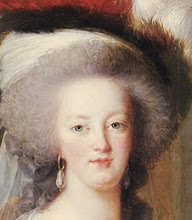Last Letters: Prisons and Prisoners of the French Revolution by Olivier Blanc is an exploration of prisons and prisoners of the French Revolution through first-hand accounts, memoirs and--as the title would suggest--last letters written by condemned prisoners. The first section of the book details the conditions of the numerous prisons in revolutionary France, which ranged from horrendous to relatively livable, especially for wealthy prisoners during the earlier years of the revolution. Many prisons were in fact refubished chateaus, which were seized from emigrees, prisoners or those who had already been executed. These prisons often afforded prisoners more freedom and luxuries than the than the prisons being used in Paris, which were overcrowded, damp and increasingly restrictive as the revolution went on. This first half includes many excerpts from contemporary resources, usually the prisoners themselves, detailing their daily lives, escape attempts, and the general atmosphere of the prisons which grew increasingly restrictive and dangerous as the revolution bore on.
The second half of the book is, in my opinion, where the real "meat" of the book comes in. The second half is entirely "last letters," or the last letters written by condemned prisoners before they were executed.The letters were written to husbands, wives, children, mothers, fathers, neighbors, and even sometimes government officials. Common themes include forgiveness, debts, innocence and love--a testament to human nature. Almost all of the letters included in this volume were intercepted before delivery and never given to their intended receipiants, adding an entirely different layer to the already somber nature of these letters. Blanc typically provides an adequate background for each letter, detailing the person's lives, their crime or supposed crime, and occasionally reports of their behavior on the scaffold from contemporary newspapers.
I highly recommend this book for anyone interested in the French Revolution or the study of prisons and prisoners. It is also a moving read for anyone interested in social and personal history.
I've written out one of the shorter letters in the book. It was written by Gabriel Rochon de Wormesele, who was condemend to death for supporting the General Council of the Department of the Gironde, who in June of 1793 declared that the Natioanl Convention in Paris was corrupt and needed to be removed. The General Council also declared that they would form their own People's Commission for Public Safety that would not dissolve until the “liberty is re-established at the heart of the National Convention.”
The second half of the book is, in my opinion, where the real "meat" of the book comes in. The second half is entirely "last letters," or the last letters written by condemned prisoners before they were executed.The letters were written to husbands, wives, children, mothers, fathers, neighbors, and even sometimes government officials. Common themes include forgiveness, debts, innocence and love--a testament to human nature. Almost all of the letters included in this volume were intercepted before delivery and never given to their intended receipiants, adding an entirely different layer to the already somber nature of these letters. Blanc typically provides an adequate background for each letter, detailing the person's lives, their crime or supposed crime, and occasionally reports of their behavior on the scaffold from contemporary newspapers.
I highly recommend this book for anyone interested in the French Revolution or the study of prisons and prisoners. It is also a moving read for anyone interested in social and personal history.
I've written out one of the shorter letters in the book. It was written by Gabriel Rochon de Wormesele, who was condemend to death for supporting the General Council of the Department of the Gironde, who in June of 1793 declared that the Natioanl Convention in Paris was corrupt and needed to be removed. The General Council also declared that they would form their own People's Commission for Public Safety that would not dissolve until the “liberty is re-established at the heart of the National Convention.”
---
to Citizeness Wormeselle, rue du Temple, no 1
12 Brumaire.
These are the last letters that my hand will trace. In a few hours I shall be no more. I am condemned to death. My wife, whom I have always lovingly cherished, I die full of love for you. I do not ask you to remember me; I know your fine soul, your loving heart, no, you will never forget me. But go on living for our poor children. Remember me to them. May I serve as an example to them, may they be better than I. Raise them in the practice of the virtues. My property has been confiscated; there was so little that it will be no great loss to them. Raise them in the love of work. Lavish upon them all the love that you had for me. Farewell, a thousand times farewell. Wipe away your tears and concern yourself only with our children.
Wormeselle.
12 Brumaire.
These are the last letters that my hand will trace. In a few hours I shall be no more. I am condemned to death. My wife, whom I have always lovingly cherished, I die full of love for you. I do not ask you to remember me; I know your fine soul, your loving heart, no, you will never forget me. But go on living for our poor children. Remember me to them. May I serve as an example to them, may they be better than I. Raise them in the practice of the virtues. My property has been confiscated; there was so little that it will be no great loss to them. Raise them in the love of work. Lavish upon them all the love that you had for me. Farewell, a thousand times farewell. Wipe away your tears and concern yourself only with our children.
Wormeselle.




